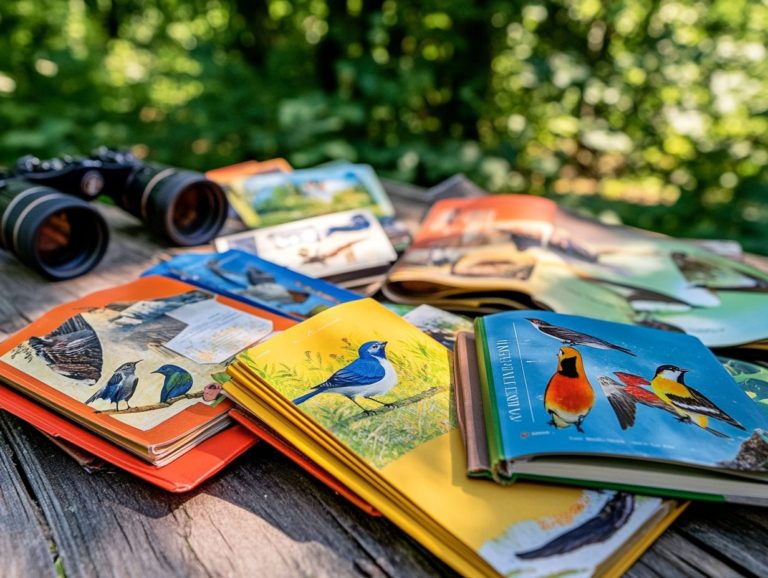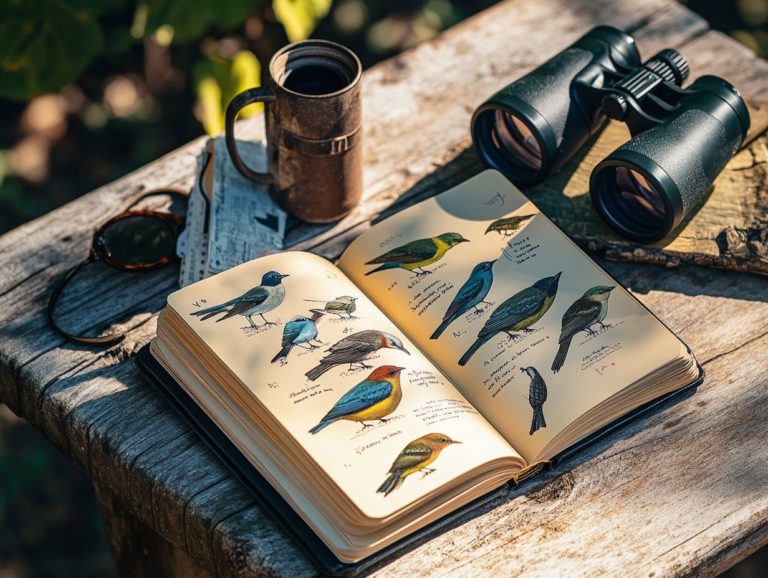Field Guides: Building Your Birdwatching Knowledge
Field guides are essential for birdwatching. They offer a wealth of knowledge for both beginners and experienced birders.
Field guides sharpen your bird identification skills and enrich your understanding of bird behaviors and habitats. This article explores the advantages of using field guides and how to choose the right one for you.
Prepare to elevate your birdwatching experience today!
Contents
- Key Takeaways:
- Benefits of Using Field Guides for Birdwatching
- Choosing the Right Field Guide for You
- How to Use a Field Guide Effectively in Birdwatching
- Key Features to Look For
- Tips for Quick and Accurate Identification
- Building Your Birdwatching Knowledge with Field Guides
- Continued Learning and Improvement
- Frequently Asked Questions
Key Takeaways:

- Field guides are crucial for identifying birds and understanding their behavior.
- Select a field guide based on format and level of detail that fits your needs.
- Utilize key features like illustrations and maps for quick identification.
What are Field Guides?
Field guides are critical tools for birdwatching, offering detailed insights into birds of North America. Resources like Field Guides: Navigating the World of Birds can enhance your experience and knowledge.
You can choose between beautifully printed guides with rich illustrations or online platforms like All About Birds that offer interactive features.
Whether you’re a beginner or an expert, these guides enhance your bird identification experience by understanding bird behavior with field guides. They cover various aspects of each species, including bird songs and unique characteristics.
When comparing printed guides like the Sibley Guide and National Geographic Field Guide to Birds with online options, each has its advantages. Printed guides offer exquisite illustrations, while online options provide updated content through smartphone apps.
Both approaches help you identify birds accurately and enhance your enjoyment of birdwatching.
Benefits of Using Field Guides for Birdwatching
Using field guides: tips for new bird watchers improves both the pleasure and effectiveness of birdwatching. These guides enhance your identification skills and deepen your understanding of bird behavior.
Incorporating these tools into your adventures fosters a deeper connection with nature and the birding community. You ll see your skills develop through focused observation and thoughtful analysis.
Enhancing Identification Skills
Improving your identification skills is a primary benefit of field guides. They provide essential information about field marks, behavior, and habitat preferences.
Regular use sharpens your visual recognition and helps you distinguish between similar bird species.
Field guides like the National Geographic Field Guide and Sibley Guide excel with detailed illustrations and descriptions, making them essential for every birdwatcher. These features enhance your understanding of birds in their natural settings.
Practice in the field by comparing sightings with illustrations. This will reinforce your learning and build confidence over time.
Learning about Bird Behavior and Habitat
Understanding bird behavior and habitat is key for birdwatchers. It can elevate your experiences in the field.
Field guides provide valuable insights into where different species live, their migration habits, and their social behaviors. Understanding how they enhance your bird watching helps you fine-tune your outings and increases your chances of spotting specific birds.
Take the Eastern Bluebird. You ll often find it in open fields and meadows. There, it hunts for insects and raises its young in tree cavities.
Paying attention to these habitats and the birds’ striking courtship displays in spring can significantly enhance your observation experience.
Similarly, the American Robin uses loud calls and foraging activities to signal its presence in gardens and parks. Recognizing how behavior and habitat connect enriches your experience and nurtures a deeper appreciation for local ecosystems.
This understanding shows why conservation efforts are important to protect these vital environments.
Choosing the Right Field Guide for You

Selecting the right field guide is crucial for both novice and seasoned birdwatchers. It impacts the overall birdwatching experience.
With many options, like the Sibley Guide, Peterson Guide, Kaufman Guide, and Crossley ID Guide, choose a guide that matches your needs and regional interests.
This selection can elevate your birdwatching and deepen your connection with nature.
Types of Field Guides
You ll find various field guides for birdwatching, each catering to unique preferences.
Seasoned birders may prefer intricate illustrations in printed guides. In contrast, digital platforms offer interactive features and up-to-date information.
The stunning illustrations in the National Geographic guide are a must-have for appreciating avian beauty. Additionally, field guides: essential tools for bird conservation often include sounds and videos, creating an immersive experience that enhances your skills.
Resources like the Merlin Bird ID app use location-based data, appealing to both newcomers and enthusiasts. This focus on specific regions makes your birdwatching journey more engaging and educational.
Factors to Consider
When choosing a field guide, consider key factors to ensure it meets your needs. Think about the geographical area you frequent and your level of experience.
Your personal preferences, such as details in illustrations or photographs, can enhance your enjoyment. If you re interested in migration habits or regional species, choose a guide that specializes in these areas.
Context matters too. Whether you’re on a guided trip or enjoying casual observation in your backyard can influence your guide choice. Exploring multiple guides helps you find the style that resonates best with your approach to birdwatching.
How to Use a Field Guide Effectively in Birdwatching
Using a field guide effectively is crucial for enhancing your birdwatching experience. Whether you prefer a printed guide or a smartphone app like Merlin Bird ID, mastering these resources can boost your bird identification skills.
Key Features to Look For
When selecting a field guide, consider the key features that will elevate your bird identification experience. Look for comprehensive illustrations, detailed species descriptions, and useful indices that allow for quick reference and easy navigation through the many birds in the guide.
Elements such as clear images of field marks can significantly help you distinguish between similar species. Information about bird songs will enrich your experience, enabling you to identify birds by sound while you’re out in the field. Guidance on local habitats is invaluable, helping you understand where to find specific birds and what to expect in different environments.
By prioritizing these features, you can customize your choice of guide to match your unique techniques and interests. This ultimately enhances your birdwatching adventures and deepens your connection to the avian world.
Tips for Quick and Accurate Identification

Identify birds quickly and accurately with these effective strategies! Familiarize yourself with key field marks and use memory tricks to spot birds fast, turning your outings into moments of discovery.
Create a mental checklist of the most common species in your area. As you observe, focus on distinguishing features such as color patterns, size variations, and specific markings that set each bird apart.
Training your ear to recognize various bird songs and calls can significantly speed up the identification process. With consistent practice in different settings, you will sharpen these skills over time, making each birdwatching expedition more rewarding and enriching.
Building Your Birdwatching Knowledge with Field Guides
Using field guides is an exciting way to deepen your love for birdwatching! Engaging with these guides not only helps you with identification but also inspires ongoing learning about various species, habitats, and behaviors.
This engagement connects you with a broader birding community and enhances your overall birding skills, enriching the experience even further.
Continued Learning and Improvement
Continued learning is essential for you as a birdwatcher who wants to refine your skills and expand your knowledge of birds. Regularly diving into field guides and participating in local birding events exposes you to new species, identification techniques, and the latest discoveries in the study of birds, while fostering a sense of belonging within the birding community.
By joining birdwatching groups, you connect with like-minded individuals and create opportunities for shared experiences and advice on unique sightings. Attending workshops led by experts can deepen your understanding of avian behavior and conservation methods.
Utilizing smartphone apps for real-time data opens up a wealth of curated information on bird calls and migration patterns, all at your fingertips. Exploring various online resources, such as guides and forums, can also enhance your journey. Networking with fellow birders encourages collaboration and the exchange of insights, ultimately elevating your growth and knowledge in this captivating field.
Frequently Asked Questions
What is a field guide?
A field guide is a book or resource that provides information and images of different species of birds, typically used for birdwatching and identification purposes.
Why should I use a field guide?

Field guides can help you build your birdwatching knowledge by providing accurate information about different species of birds, their habitats, behaviors, and identification tips.
How do I choose the right field guide?
When choosing a field guide, think about where you’ll be birdwatching and the types of birds you’re interested in. Check with experienced birdwatchers for their recommendations.
Can I use a field guide on my phone or computer?
Yes! There are numerous digital field guides available for download. They re great for quick references in the field, although some birdwatchers still favor physical copies.
Are there different types of field guides?
Absolutely! Field guides come in various forms. You can find general guides, specialized ones for specific regions, and interactive birding apps that offer real-time updates.
Can I create my own field guide?
Yes, you can! Many birdwatchers compile personal guides by gathering information and photos of their sightings. This can be an exciting and educational adventure!






